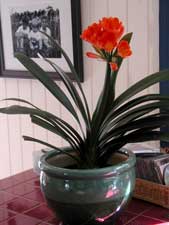Resource Library
Plant of the Week: Lily, Kaffir
The University of Arkansas System Division of Agriculture does not promote, support or recommend plants featured in "Plant of the Week." Please consult your local Extension office for plants suitable for your region.
Plant of the Week
Kaffir Lily
Latin: Clivia miniata

Gardening is both an individual activity and a communal experience. The urge to know more, share experiences and brag about your accomplishments is strong and has never been easier since the Internet arrived. Now every imaginable plant group has its own advocacy group. One of the latest to catch my attention has been the various Clivia societies.
Clivias, the most common of which is Clivia miniata, are South African members of the amaryllis family sometimes called Kaffir lilies, bush lilies or, most commonly, just Clivia. Six species have been described to date. This species is a frost-tender, clump-forming perennial growing about 30 inches tall when in flower.
It has 2-inch broad, 2-foot long evergreen leaves arranged in a fan from the central crown. As the plant gets older, the crown will branch and additional fans form. Variegated foliage types with broad white or yellow stripes down the length of the leaf are available and command high prices. From the center of each fan of leaves the flowering scape emerges in the spring or early summer.
Twenty or so large, 2-inch long trumpet shaped flowers are borne in a dense terminal cluster. Flower color is typically orange but hybridizers have been busy in recent years and selections are now available in shades or orange-red, yellow and creamy white. Flowers remain in bloom for three to four weeks when clivia is grown as a houseplant. If the plants have multiple crowns, bloom scapes will emerge at different times and extend the length of the bloom season.
Interest in clivias has been keen since the public debut of the first C. miniata in 1854, but it was just one of many tender greenhouse plants to most plant people. It was not until the 1992 that clivias gained enough momentum to sustain their own society. That year the South African Clivia Society formed with 25 members; 16 from South Africa, five from Australia, two from the
United States and one each from Hong Kong and Japan. Today, thanks to the Internet, they number more than 1,000 members, and there are at least four competing clivia societies, many with their own local chapters.
The Internet adds a new dimension to sharing, making it possible for enthusiasts who will possibly never meet to engage one another. It also provides a forum for plant exchange. Clivias are slow growing and the unusual color variants remain rare, so the Internet has become a means of doling out special plants to the high bidder via online auctions.
Because of the difficulty of shipping plants internationally, the auctions occur within each country. In the United States auction, sponsored by the North American Clivia Society, plants routinely sell for as much as $250 each.
Clivias are among the easiest flowering houseplants to keep around. Give them a big pot - an 8-inch or larger container is best - a well drained organic potting mix, occasional fertilization and water enough to ensure they never completely dry out and you’re set.
They are shade plants in nature, so never expose them to direct sunlight except in the winter when the light intensity is naturally low. In the wintertime, they can be kept in a cool bedroom or even in the garage so long as they don’t freeze.
In the spring as the days brighten and temperatures warm, clivias bloom. After flowering, fertilize the plant with a slow release fertilizer and move it out of doors once the danger of frost is past. Locate it in the shade garden or on the shaded patio and allow it to summer outside. If the plant has offsets, divide it when it is moved outside. Fresh seed will germinate without treatment. Other than an occasional mealybug or scale attack, clivias are virtually pest free.
By: Gerald Klingaman, retired
Extension Horticulturist - Ornamentals
Extension News - April 27, 2007
The University of Arkansas System Division of Agriculture does not maintain lists of retail outlets where these plants can be purchased. Please check your local nursery or other retail outlets to ask about the availability of these plants for your growing area.